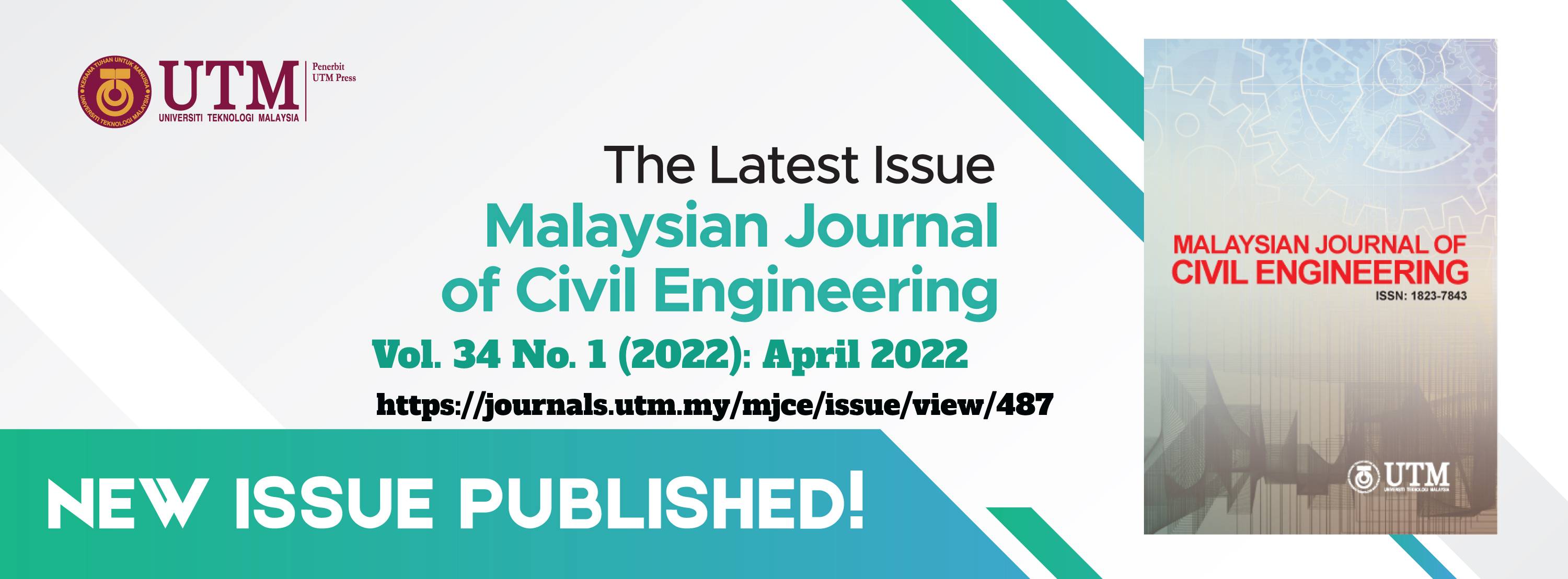MODELS TO PREDICT THE FRESH AND HARDENED PROPERTIES OF PALM KERNEL SHELL CONCRETE
DOI:
https://doi.org/10.11113/mjce.v34.17710Keywords:
Concrete, Compressive Strength, Model, Palm Kernel Shell, SlumpAbstract
Concrete is an assemblage of Cement, aggregates and water, the most frequently used fine aggregate for concrete production is sand sourced from river banks. The continuous exploitation of available granite conventionally used as coarse aggregate in concrete production coupled with rapid infrastructural development has resulted in its scarcity and often high cost. The suitability of utilising Palm Kernel Shell (PKS) as partial replacement for coarse aggregate in concrete production was examined in this paper. Preliminary tests were conducted on all aggregates to determine their suitability for concrete production. Concrete with 5, 10, 15, 20 and 25% PKS-coarse aggregate content was cast with a mix ratio of 1:2:4. The freshly prepared Palm Kernel Shell Concrete (PKSC) was cast in moulds measuring 150 x 150 x 150mm and cured using ponding method. The Compressive strength result shows that an increase in the PKS content results in a decrease in compressive strength of concrete. Linear regression models for the slump and compressive strength of the PKSC were developed and found to be sufficient in predicting the compressive strengths with R2 values of 96% and 92 % respectively.
References
Asuzu, C. C., Okereke, C. D., Asoegwu, S. N., and Nwachukwu, P. I. 2017. Suitability of Agricultural Waste Product (Palm Kernel Shell) as Coarse Aggregate in Concret: A Review. International Journal of Agriculture, Environment and Bioresearch. 2(2): 313-319.
Azunna, S. U. 2019. Compressive strength of concrete with palm kernel shell as a partial replacement for coarse aggregate. SN Applied Sciences. 1: 342. DOI: https://doi.org/10.1007/s42452-019-0334-6.
BS 12 1996. Specification for Portland Cement. British standard Portland. British standard Institute. 2 Park Street, London WIA 2BS.
BS 882 1992. Specification for aggregates from natural sources for concrete. British Standard Institution. 2 Park Street, London WIA 2BS.
BS 1881 Part 116, 1983. Method for Determining Compressive Strength of Concrete Cubes, British Standard Institution, Her Majesty Stationary office London.
BS EN 1008 2002. Mixing water for concrete: Specification for sampling, testing and assessing the suitability of water, including water recovered from concrete industry as mixing water for concrete. London, British Standards Institution.
BE EN 12350-2 2019. Testing Fresh Concrete Part 2: Slump test. British Standards Institution.
Ezeifula, U. G., Opara, H. E., and Anya, C. U. 2017. Mechanical Properties of Palm Kernel Shell Concrete in Comparison with Periwinkle Shell Concrete. Malaysian Journal of Civil Engineering. 29(1): 1-14.
Gibigaye, M., Godonou, G. F., Katte, R., and Degan, G. 2017. Structured mixture proportioning for oil palm shell concrete. Elsevier: Case Studies in Construction Materials. 6: 219 – 224.
Itam, Z., Beddu, S., Kamal, N. L. M., and Alam, M. A. 2016. The Feasibility of Palm Kernel Shell as a Replacement for Coarse Aggregate in Lightweight Concrete. International Conference on Advances in Renewable Energy and Technologies (ICARET).
Kolo, D. N. 2019. Safety and Reliability Studies of Reinforced Concrete Structural Elements in Buildings. Unpublished PhD Thesis, Department of Civil Engineering, Federal University of Technology, Minna, Nigeria.
Mo, K. H., Alengaram, U. J., and Jumaat, M. Z. 2015. Experimental investigation on the Properties of Lightweight Concrete containing Waste oil palm shell aggregate. Procedia Engineering. 125, 587-593.
Ndoke, P. N. 2006. Performance of palm kernel shells as partial replacement for coarse aggregate in asphalt concrete. Leonardo Electronic Journal of Practices and Technologies, 5(9): 145-152.
Nduka, D. O., Fagbenle, O. I., Joshua, O., Ogunde, A. O., and Omuh, I. O. 2018. Comparative Analysis of Concrete Strength Utilizing Quarry-crushed and Locally sourced Coarse Aggregates. International Journal of Mechanical Engineering and Technology (IJMET), 9(1): 609-617.
Nevile, A. M. and Brookes J. J. 2008. Concrete Technology, Revised edition. Pearson Education Limited, Edinburgh gate, Harlow, Essex CM20 2JE, England.
Osei, D. Y., and Jackson, E. N. 2012. Experimental study on Palm Kernel Shells as Coarse Aggregates in Concrete. International Journal of Scientific and Engineering Research, 3(8): 1-6.
Purwanti, H., and Artiningsih, T. P. 2018. Palm kernel Shell as an alternative Aggregate on High Performance Concrete. Journal of Science Innovare. 1(2) p-ISSN:2615-3769; e-ISSN: 2615-3750.
Williams, F. N., Ijigah, E. A., Anum, I., Isa, R. B., and Obanibi, A. O. 2014. Suitabilty of Palm Kernel Shell as Coarse Aggregate in Lightweight Concrete Production. Civil and Engineering Research, 6(7): 55-59.
















